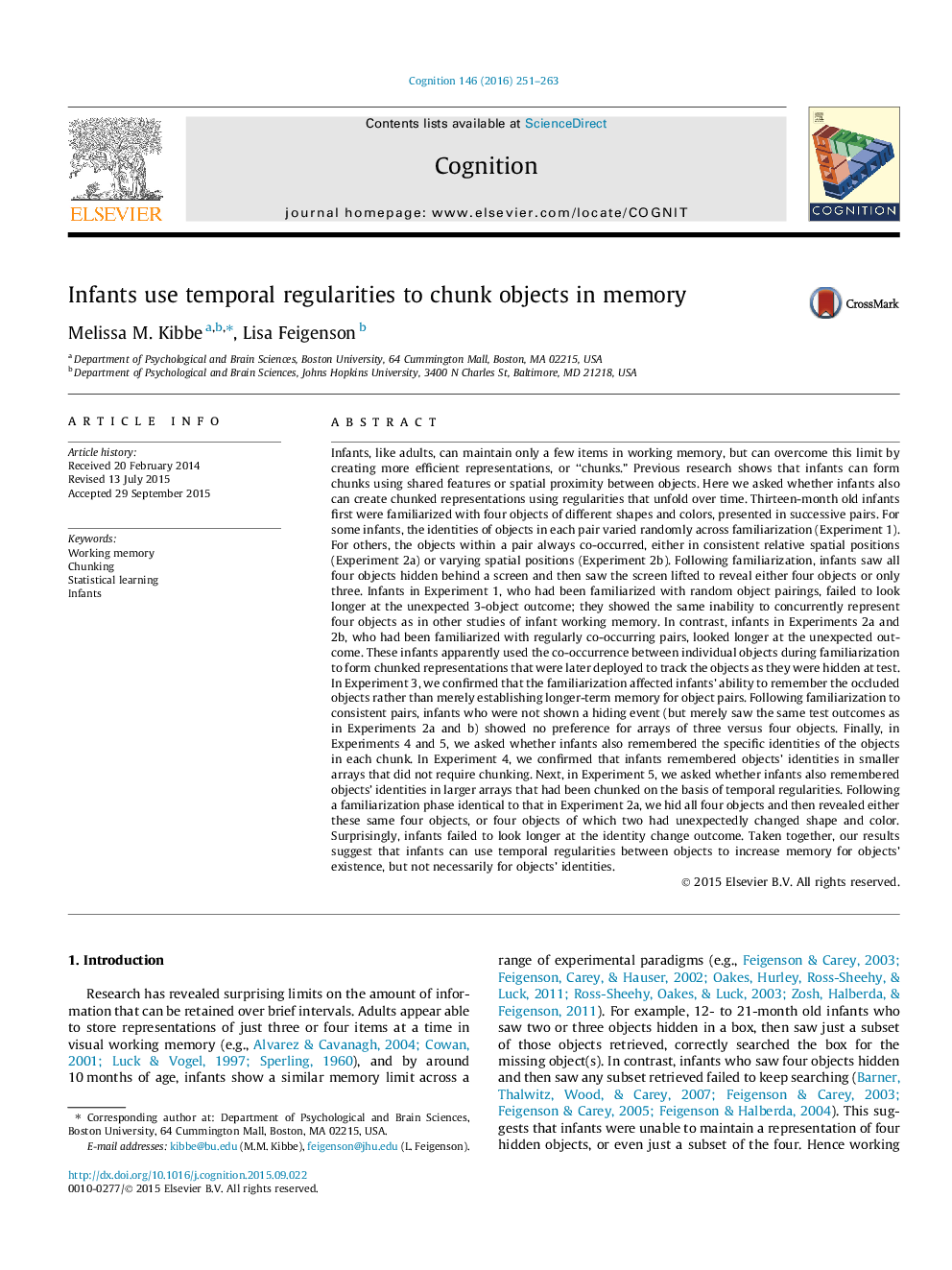| کد مقاله | کد نشریه | سال انتشار | مقاله انگلیسی | نسخه تمام متن |
|---|---|---|---|---|
| 7286420 | 1474121 | 2016 | 13 صفحه PDF | دانلود رایگان |
عنوان انگلیسی مقاله ISI
Infants use temporal regularities to chunk objects in memory
ترجمه فارسی عنوان
نوزادان با استفاده از قوانین جسمانی به اشیاء ریز در حافظه می پردازند
دانلود مقاله + سفارش ترجمه
دانلود مقاله ISI انگلیسی
رایگان برای ایرانیان
کلمات کلیدی
حافظه کاری، خرابکاری، یادگیری آماری، نوزادان،
موضوعات مرتبط
علوم زیستی و بیوفناوری
علم عصب شناسی
علوم اعصاب شناختی
چکیده انگلیسی
Infants, like adults, can maintain only a few items in working memory, but can overcome this limit by creating more efficient representations, or “chunks.” Previous research shows that infants can form chunks using shared features or spatial proximity between objects. Here we asked whether infants also can create chunked representations using regularities that unfold over time. Thirteen-month old infants first were familiarized with four objects of different shapes and colors, presented in successive pairs. For some infants, the identities of objects in each pair varied randomly across familiarization (Experiment 1). For others, the objects within a pair always co-occurred, either in consistent relative spatial positions (Experiment 2a) or varying spatial positions (Experiment 2b). Following familiarization, infants saw all four objects hidden behind a screen and then saw the screen lifted to reveal either four objects or only three. Infants in Experiment 1, who had been familiarized with random object pairings, failed to look longer at the unexpected 3-object outcome; they showed the same inability to concurrently represent four objects as in other studies of infant working memory. In contrast, infants in Experiments 2a and 2b, who had been familiarized with regularly co-occurring pairs, looked longer at the unexpected outcome. These infants apparently used the co-occurrence between individual objects during familiarization to form chunked representations that were later deployed to track the objects as they were hidden at test. In Experiment 3, we confirmed that the familiarization affected infants' ability to remember the occluded objects rather than merely establishing longer-term memory for object pairs. Following familiarization to consistent pairs, infants who were not shown a hiding event (but merely saw the same test outcomes as in Experiments 2a and b) showed no preference for arrays of three versus four objects. Finally, in Experiments 4 and 5, we asked whether infants also remembered the specific identities of the objects in each chunk. In Experiment 4, we confirmed that infants remembered objects' identities in smaller arrays that did not require chunking. Next, in Experiment 5, we asked whether infants also remembered objects' identities in larger arrays that had been chunked on the basis of temporal regularities. Following a familiarization phase identical to that in Experiment 2a, we hid all four objects and then revealed either these same four objects, or four objects of which two had unexpectedly changed shape and color. Surprisingly, infants failed to look longer at the identity change outcome. Taken together, our results suggest that infants can use temporal regularities between objects to increase memory for objects' existence, but not necessarily for objects' identities.
ناشر
Database: Elsevier - ScienceDirect (ساینس دایرکت)
Journal: Cognition - Volume 146, January 2016, Pages 251-263
Journal: Cognition - Volume 146, January 2016, Pages 251-263
نویسندگان
Melissa M. Kibbe, Lisa Feigenson,
